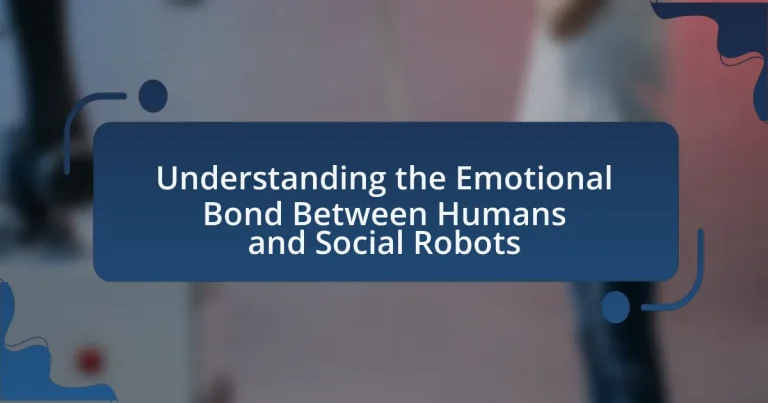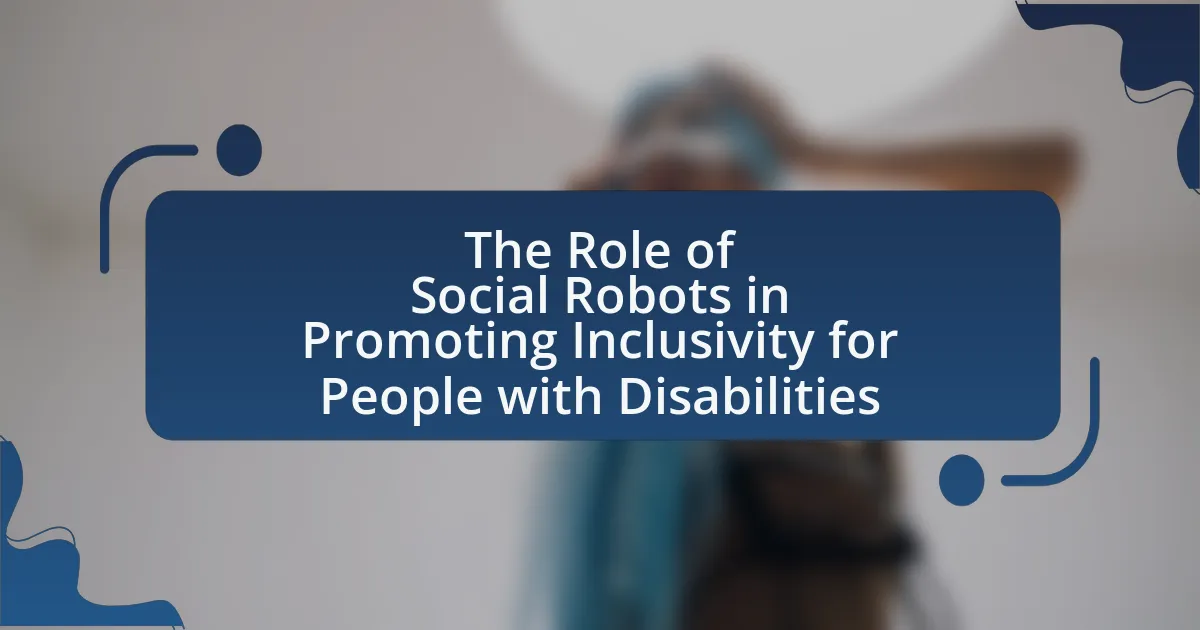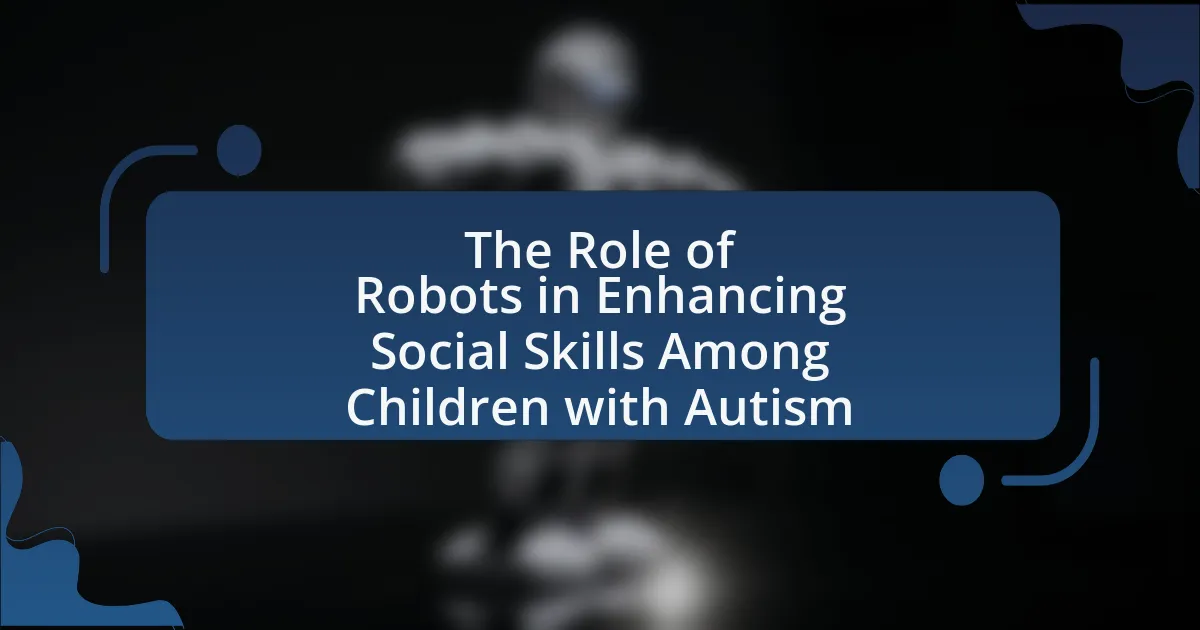The article focuses on the emotional bond between humans and social robots, characterized by attachment, empathy, and social interaction. It explores how humans perceive social robots emotionally, the factors influencing emotional attachment, and the impact of robot design on emotional responses. Key components of this bond include trust, companionship, and shared experiences, which are essential for enhancing human-robot interactions. The article also discusses the significance of empathy in fostering these connections and the practical applications of understanding this bond in fields such as healthcare and education. Additionally, it addresses the challenges in measuring emotional bonds and the implications for future robot development.
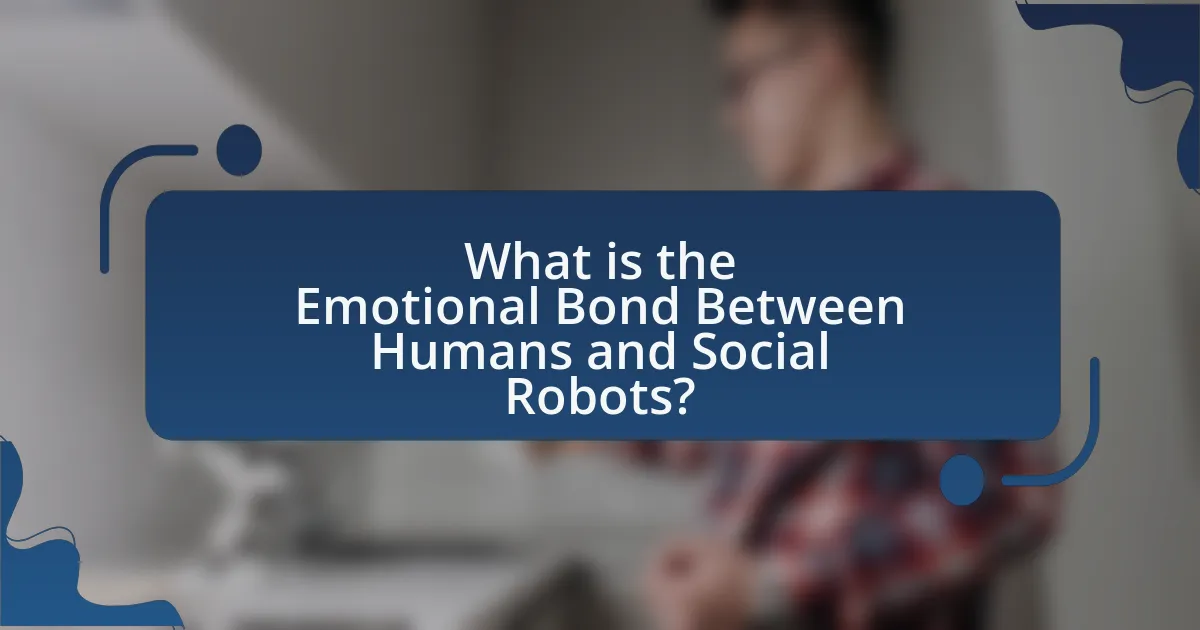
What is the Emotional Bond Between Humans and Social Robots?
The emotional bond between humans and social robots is characterized by attachment, empathy, and social interaction. Research indicates that humans can develop feelings of companionship and trust towards social robots, often attributing human-like qualities to them. For instance, studies have shown that individuals interact with robots in ways similar to human relationships, demonstrating emotional responses such as affection and concern. A notable example is the work by Breazeal et al. (2004), which highlights how social robots like Kismet can elicit emotional responses through expressive behaviors, reinforcing the bond between humans and robots. This emotional connection is further supported by findings that suggest social robots can positively influence mental well-being, particularly in therapeutic settings, by providing companionship and reducing feelings of loneliness.
How do humans perceive social robots emotionally?
Humans perceive social robots emotionally by attributing human-like qualities to them, which can evoke feelings of empathy, companionship, and attachment. Research indicates that when social robots exhibit behaviors such as facial expressions, vocal tones, and gestures, individuals are more likely to respond emotionally, similar to how they would interact with other humans. For instance, a study published in the journal “Robotics and Autonomous Systems” by Breazeal et al. (2016) found that participants reported feelings of affection and trust towards robots that displayed social cues, reinforcing the idea that emotional perception is influenced by the robot’s ability to communicate and engage in social interactions.
What factors influence emotional attachment to social robots?
Emotional attachment to social robots is influenced by several key factors, including anthropomorphism, social presence, and user experience. Anthropomorphism refers to the extent to which users perceive robots as having human-like characteristics, which can enhance emotional connections; studies show that robots designed with human-like features elicit stronger emotional responses from users. Social presence, the feeling of being with another entity, also plays a crucial role; research indicates that higher levels of perceived social presence lead to increased emotional attachment. Additionally, user experience, encompassing interaction quality and personalization, significantly impacts attachment levels; positive interactions and tailored experiences foster stronger bonds. These factors collectively shape how individuals relate to social robots, reinforcing the emotional bond between humans and these technologies.
How does the design of social robots affect emotional responses?
The design of social robots significantly influences emotional responses by shaping user perceptions and interactions. Features such as facial expressions, voice tone, and body language in robot design can evoke empathy and attachment in users. For instance, research by Breazeal (2003) demonstrated that robots with human-like features elicit stronger emotional connections compared to those with mechanical designs. Additionally, a study published in the journal “Robotics and Autonomous Systems” found that users reported higher levels of trust and comfort when interacting with robots designed to mimic human social cues. These design elements create a more relatable and engaging experience, ultimately enhancing emotional responses.
Why is understanding this bond important?
Understanding the emotional bond between humans and social robots is important because it influences user acceptance, interaction quality, and the effectiveness of robotic applications in various settings. Research indicates that stronger emotional connections can enhance trust and cooperation between humans and robots, leading to improved outcomes in healthcare, education, and companionship. For instance, a study published in the journal “Human-Robot Interaction” by Fong et al. (2003) demonstrates that emotional engagement with robots can significantly affect user satisfaction and willingness to use robotic systems.
What implications does this bond have for human-robot interaction?
The emotional bond between humans and social robots significantly enhances human-robot interaction by fostering trust and improving communication. This bond allows users to perceive robots as companions rather than mere tools, leading to increased engagement and cooperation. Research indicates that when users feel an emotional connection, they are more likely to accept robots in various roles, such as caregiving or assistance, which can improve outcomes in settings like healthcare and education. For instance, a study published in the journal “Social Robotics” found that participants who formed an emotional bond with a robot were more willing to follow its guidance and interact positively, demonstrating the practical benefits of such relationships in enhancing collaborative tasks.
How can this understanding improve social robot development?
Understanding the emotional bond between humans and social robots can significantly enhance social robot development by informing design and interaction strategies that foster deeper connections. This understanding allows developers to create robots that can recognize and respond to human emotions, leading to more intuitive and engaging interactions. For instance, research indicates that robots capable of displaying empathy and emotional intelligence can improve user satisfaction and trust, as evidenced by studies showing that users prefer robots that can adapt their behavior based on emotional cues. By integrating these insights into the development process, social robots can become more effective companions, ultimately enhancing their utility in various applications such as healthcare, education, and customer service.
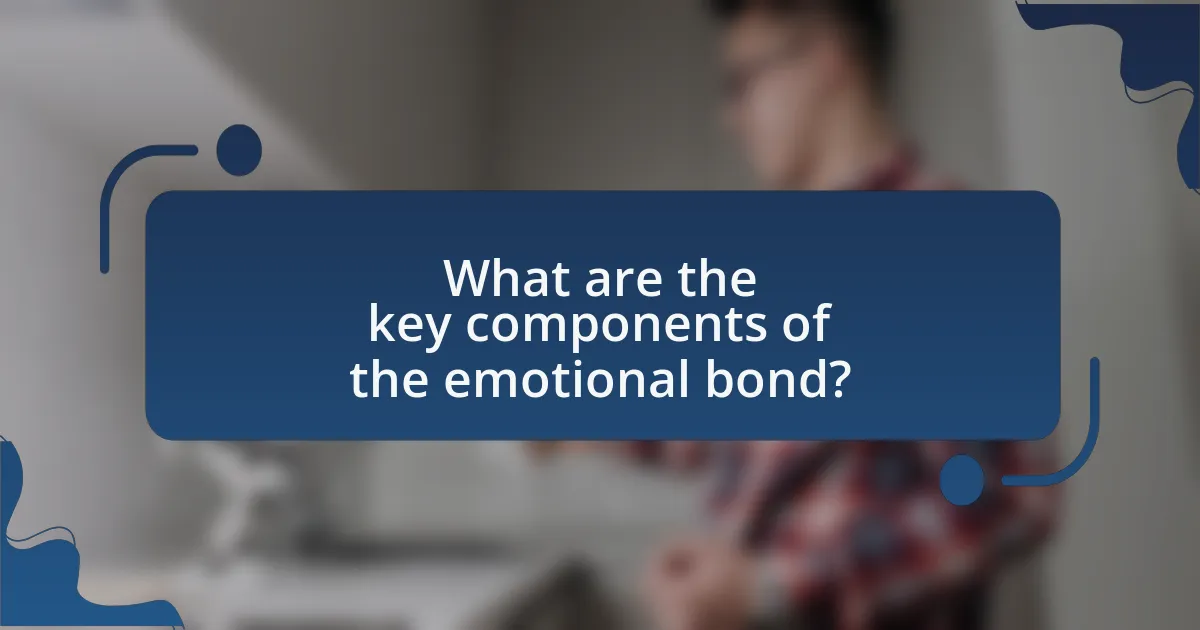
What are the key components of the emotional bond?
The key components of the emotional bond include attachment, trust, empathy, and shared experiences. Attachment refers to the emotional connection that develops over time, often characterized by a sense of security and comfort. Trust is essential for forming a reliable relationship, allowing individuals to feel safe in expressing their emotions. Empathy involves understanding and sharing the feelings of another, fostering deeper connections. Shared experiences create a sense of belonging and mutual understanding, reinforcing the emotional bond. These components are supported by psychological research, which indicates that strong emotional bonds enhance interpersonal relationships and improve overall well-being.
How do empathy and companionship play a role?
Empathy and companionship significantly enhance the emotional bond between humans and social robots by fostering trust and emotional connection. Empathy allows humans to relate to robots on a personal level, facilitating interactions that feel more genuine and supportive. Research indicates that when robots exhibit empathetic behaviors, such as responding to human emotions, users report higher satisfaction and a stronger sense of companionship. For instance, a study published in the journal “Human-Computer Interaction” by F. A. M. de Graaf and A. M. Allouch found that users perceived robots as more trustworthy and engaging when they displayed empathetic responses. This dynamic not only improves user experience but also encourages ongoing interaction, reinforcing the emotional bond.
What is the significance of empathy in human-robot relationships?
Empathy is significant in human-robot relationships as it enhances user engagement and trust. When robots exhibit empathetic behaviors, such as responding to human emotions or providing emotional support, users are more likely to form a positive connection with them. Research indicates that empathetic robots can improve user satisfaction and cooperation, as demonstrated in studies where robots that recognized and responded to emotional cues led to increased user compliance and interaction quality. For instance, a study published in the journal “Science Robotics” by F. A. M. de Graaf and A. A. M. Allouch found that users reported higher levels of trust and emotional connection with robots that displayed empathetic responses compared to those that did not. This underscores the importance of empathy in fostering meaningful human-robot interactions.
How do social robots provide companionship to users?
Social robots provide companionship to users by engaging in interactive communication and emotional support. These robots utilize artificial intelligence to recognize and respond to human emotions, fostering a sense of connection. For instance, studies have shown that social robots can simulate empathetic responses, which enhances user satisfaction and emotional well-being. Research conducted by Sherry Turkle at MIT highlights that users often form attachments to robots that exhibit social behaviors, demonstrating the effectiveness of these interactions in creating companionship.
What psychological factors contribute to this bond?
The psychological factors that contribute to the bond between humans and social robots include attachment, anthropomorphism, and social presence. Attachment theory suggests that humans can form emotional connections with non-human entities, similar to bonds formed with caregivers. Anthropomorphism allows individuals to attribute human-like characteristics to robots, enhancing emotional engagement. Research indicates that when robots exhibit social behaviors, such as responsiveness and emotional expressions, users perceive them as more relatable, fostering a sense of companionship. For instance, a study by Breazeal (2003) demonstrated that children developed attachment to a robot that displayed social cues, reinforcing the idea that emotional bonds can form through perceived social interactions.
How does attachment theory relate to human-robot interactions?
Attachment theory relates to human-robot interactions by providing a framework for understanding how individuals form emotional bonds with robots, similar to the bonds formed with other humans. This theory posits that attachment behaviors, such as seeking proximity and comfort, can be observed in interactions with social robots, indicating that users may develop attachment styles based on their experiences with these machines. Research has shown that users often project human-like qualities onto robots, leading to emotional responses that mirror those experienced in human relationships. For example, studies indicate that individuals who perceive robots as reliable and responsive are more likely to form positive attachments, enhancing user satisfaction and engagement.
What role does trust play in forming emotional bonds with robots?
Trust is essential in forming emotional bonds with robots, as it influences users’ willingness to engage and interact with them. When individuals perceive robots as reliable and capable of fulfilling their intended roles, they are more likely to develop emotional connections. Research indicates that trust can be established through consistent performance, transparency in communication, and the robot’s ability to respond appropriately to human emotions. For instance, a study by Lee et al. (2010) found that participants were more likely to form emotional attachments to robots that demonstrated reliability and responsiveness, highlighting the direct correlation between trust and emotional bonding.
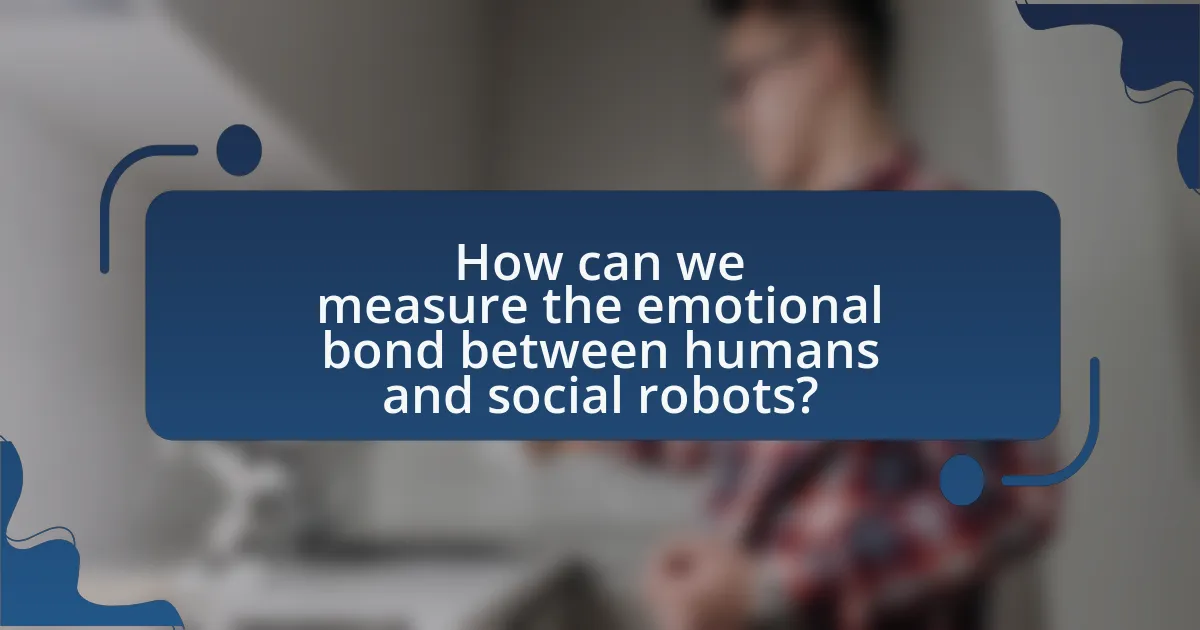
How can we measure the emotional bond between humans and social robots?
The emotional bond between humans and social robots can be measured through various methods, including surveys, behavioral observations, and physiological responses. Surveys often utilize standardized questionnaires, such as the Human-Robot Interaction (HRI) scale, to assess users’ feelings towards robots. Behavioral observations focus on interactions, noting factors like engagement duration and frequency of positive social cues. Physiological responses, such as heart rate variability and skin conductance, provide objective data on emotional arousal during interactions. Research has shown that these methods can effectively quantify emotional connections, as evidenced by studies demonstrating correlations between self-reported feelings and physiological indicators in human-robot interactions.
What methods are used to assess emotional attachment?
Methods used to assess emotional attachment include self-report questionnaires, behavioral observation, and physiological measurements. Self-report questionnaires, such as the Experiences in Close Relationships Scale, allow individuals to express their feelings and perceptions regarding attachment. Behavioral observation involves analyzing interactions between humans and social robots to identify signs of attachment, such as proximity seeking or emotional responses. Physiological measurements, like heart rate variability and skin conductance, provide objective data on emotional arousal linked to attachment experiences. These methods collectively offer a comprehensive understanding of emotional attachment dynamics.
How do surveys and interviews capture user experiences?
Surveys and interviews capture user experiences by systematically collecting qualitative and quantitative data on individuals’ perceptions, feelings, and interactions with products or services. Surveys utilize structured questionnaires to gather measurable responses, allowing for statistical analysis of user satisfaction and preferences. Interviews, on the other hand, provide in-depth insights through open-ended questions, enabling participants to express their thoughts and emotions in detail. Research indicates that combining both methods enhances understanding; for instance, a study by Dillman et al. (2014) highlights that mixed-method approaches yield richer data, revealing nuanced user experiences that surveys alone may overlook.
What role do behavioral observations play in measurement?
Behavioral observations play a crucial role in measurement by providing direct, empirical data on interactions and responses between humans and social robots. These observations allow researchers to quantify emotional bonds through specific behaviors, such as eye contact, physical proximity, and verbal communication patterns. For instance, studies have shown that increased eye contact and positive verbal interactions correlate with stronger emotional connections, highlighting the importance of these observable behaviors in assessing the quality of human-robot relationships.
What challenges exist in measuring this bond?
Measuring the emotional bond between humans and social robots presents several challenges, primarily due to the subjective nature of emotions and the complexity of human-robot interactions. One significant challenge is the lack of standardized metrics to quantify emotional responses, as emotions can vary widely among individuals and contexts. Additionally, the interpretation of emotional cues from robots can be ambiguous, as robots may not express emotions in ways that are easily recognizable to humans. Research indicates that emotional responses to robots can be influenced by factors such as design, functionality, and user expectations, complicating the measurement process. Furthermore, the dynamic nature of human emotions, which can change rapidly, makes it difficult to capture a stable measure of the bond over time.
How do cultural differences impact emotional responses to robots?
Cultural differences significantly impact emotional responses to robots by shaping perceptions, expectations, and interactions with these technologies. For instance, in collectivist cultures, such as Japan, individuals may exhibit stronger emotional bonds with robots, viewing them as companions or helpers, which is influenced by cultural narratives that emphasize harmony and social cohesion. Conversely, in individualistic cultures like the United States, emotional responses may be more skeptical or utilitarian, focusing on functionality rather than companionship. Research by Kahn et al. (2012) in “The Social Impact of Robots” highlights that cultural context influences how people attribute emotions and intentions to robots, affecting their acceptance and emotional engagement. This evidence underscores the importance of considering cultural frameworks when designing and implementing social robots to foster positive emotional connections.
What limitations do current measurement tools have?
Current measurement tools for assessing emotional bonds between humans and social robots have several limitations, including a lack of standardization, limited contextual understanding, and reliance on self-reported data. These tools often vary in their methodologies, making it difficult to compare results across studies. For instance, some tools may focus solely on physiological responses, while others might emphasize behavioral observations, leading to inconsistent findings. Additionally, many measurement tools do not account for the complex social and emotional contexts in which interactions occur, potentially overlooking critical factors that influence emotional bonding. Furthermore, self-reported measures can introduce bias, as individuals may not accurately express their feelings or may be influenced by social desirability. These limitations hinder the ability to fully understand and quantify the emotional connections between humans and social robots.
What practical applications arise from understanding this bond?
Understanding the emotional bond between humans and social robots leads to practical applications in areas such as healthcare, education, and companionship. In healthcare, social robots can provide emotional support to patients, improving mental well-being and adherence to treatment, as evidenced by studies showing reduced anxiety levels in elderly patients interacting with robotic companions. In education, robots can serve as engaging tutors, enhancing learning experiences for children, particularly those with special needs, by fostering motivation and social interaction. Additionally, in companionship, social robots can alleviate loneliness in individuals, particularly the elderly, by offering consistent interaction and emotional engagement, which has been shown to improve overall quality of life.
How can insights into emotional bonds enhance robot design?
Insights into emotional bonds can enhance robot design by enabling the creation of robots that better understand and respond to human emotions. By incorporating emotional intelligence into their programming, robots can engage in more meaningful interactions, fostering trust and companionship. Research indicates that robots designed with emotional awareness can improve user satisfaction and acceptance; for instance, a study by Fong et al. (2003) demonstrated that socially intelligent robots increased user engagement and emotional connection. This understanding allows designers to tailor robot behaviors and responses, making them more relatable and effective in various applications, such as caregiving and education.
What best practices should developers follow to foster emotional connections?
Developers should prioritize user-centered design to foster emotional connections. This involves understanding user needs, preferences, and emotions through research and feedback, which can enhance the overall user experience. For instance, incorporating empathetic responses in interactions can create a sense of understanding and connection. Studies have shown that when users perceive a system as empathetic, their emotional engagement increases, leading to stronger bonds. Additionally, personalization features, such as adapting responses based on user behavior, can further enhance emotional ties, as users feel recognized and valued.
